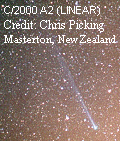What's Up in Space -- 28 May 2001
Subscribe to Space Weather News! IMPACT: An interplanetary shock wave buffeted Earth's magnetosphere Sunday at 1500 UT, but the impact did not trigger substantial geomagnetic activity. The disturbance, which raised the solar wind velocity near Earth to nearly 650 km/s, was the leading edge of a faint full-halo coronal mass ejection [350 kb movie] that billowed away from the Sun last Friday.   DOUBLE ASTEROID: Astronomers announced last week that near-Earth asteroid 1999 KW4 -- a space rock that passed 12.6 lunar distances from Earth on May 25th -- is a binary! Data from NASA's Goldstone Planetary Radar reveal "separations up to at least 2 km between the components, whose sizes differ by a factor of at least three." 1999 KW4 was brightest on May 27th at magnitude 10.7, but it will remain an easy target for modest amateur telescopes equipped with CCD cameras during the next week as it slowly fades. [3D orbit] [ephemeris] [movies] DOUBLE ASTEROID: Astronomers announced last week that near-Earth asteroid 1999 KW4 -- a space rock that passed 12.6 lunar distances from Earth on May 25th -- is a binary! Data from NASA's Goldstone Planetary Radar reveal "separations up to at least 2 km between the components, whose sizes differ by a factor of at least three." 1999 KW4 was brightest on May 27th at magnitude 10.7, but it will remain an easy target for modest amateur telescopes equipped with CCD cameras during the next week as it slowly fades. [3D orbit] [ephemeris] [movies]
1999 KW4 is a rare asteroid that passes even closer to the Sun than Mercury does. It travels around our star once every 188 days following an elliptical orbit that stretches from 0.2 AU to 1.08 AU. Some scientists think 1999 KW4 might be the nucleus of an extinct comet. CRUMBLING COMET: Comet C/2000 A2 (LINEAR) is falling apart! The ESO's Very Large Telescope in Chile revealed on May 18th that the comet's icy core contained at least three "mini-comets" -- continuing a general disintegration that began in late April. This is a naked eye object for southern hemisphere sky watchers, but just barely. At visual magnitude 5.1, the comet is best viewed through binoculars.  Right: Chris Picking captured this image of comet LINEAR's six degree-long tail on May 13th using a 35mm camera, 135mm lens, 10 minutes exposure, and Kodak Supra 400 film. Right: Chris Picking captured this image of comet LINEAR's six degree-long tail on May 13th using a 35mm camera, 135mm lens, 10 minutes exposure, and Kodak Supra 400 film.
The comet's appearance is changing as volatile ices in the fragmenting nucleus are newly exposed to solar radiation. It will likely brighten even more as it approaches Earth between now and June 30th, when the comet will be just 0.23 AU from our planet. Meanwhile, it made its closest approach to the Sun (0.78 AU) on May 24th. See: [3D orbit][ephemeris] WEB LINKS: NOAA FORECAST | GLOSSARY | SPACE WEATHER TUTORIAL | LESSON PLANS | BECOME A SUBSCRIBER | 
